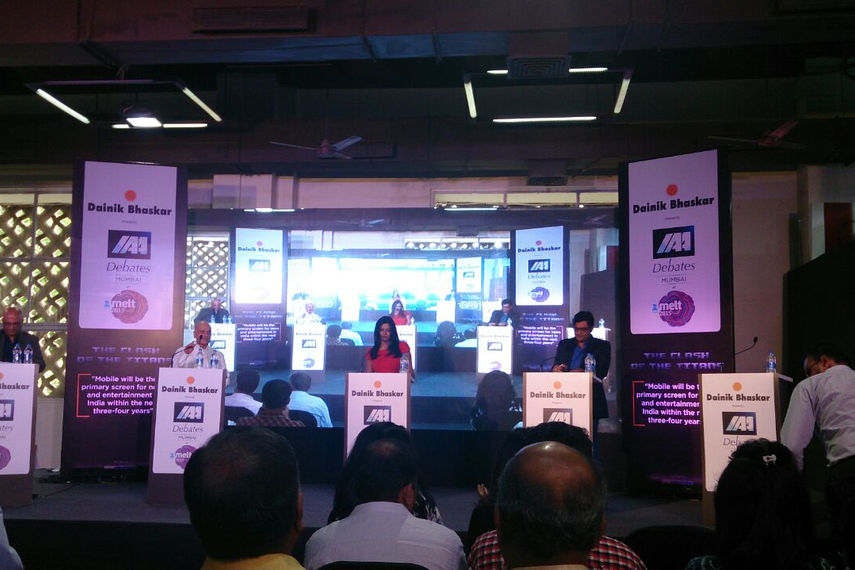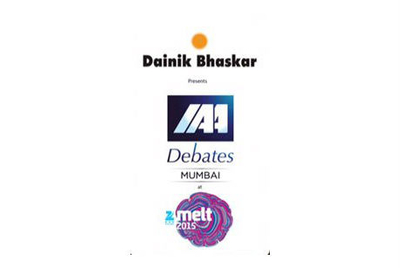‘Mobile will not be the primary screen for news and entertainment in India in the next three-four years’ was the verdict at the ninth edition of the IAA Debates, presented by Dainik Bhaskar, and hosted on the first day of Melt 2015.
Raghav Bahl, founder and former MD, Network18, along with Madison’s Vikram Sakhuja spoke FOR the motion, that the mobile would be the primary screen for news and entertainment in India in the next three to four years.
Times Now’s editor-in-chief, Arnab Goswami and Rajiv Lochan, MD and CEO, The Hindu group of publications, spoke AGAINST the motion.
ET Now's Sonali Krishna moderated the debate.
Sakhuja, the first speaker, referred to the growth of e-mail. He said, “Nobody opposes the fact that e-mail will be the prime medium for sending mail in India. This is because 6.8 million mails were sent via post in 2011. The e-mails sent during the same period were three times the amount. If technology has made so much of a difference to mails, then why will mobile not become a primary screen? With respect to news and entertainment, mobile will be the screen most viewed. News in this current age will be consumed on this (mobile).”
Goswami was quick to interrupt. “The subject is not about ‘news and entertainment’, but it is about ‘news and entertainment’ being the primary screen in the next 'three to four years’”, said Goswami.
Sakhuja responded, “The operational words are ‘news’ and ‘entertainment’. The point is that news is consumed on bite-sized devices and that will definitely increase. With respect to entertainment, we are definitely seeing more 30, 60 minute shows and movies, but there’s a lot of ‘snack sized’ content too, and for that the primary device will be the mobile. If you take a market like the US, TV consumption has gone down to 40 per cent. Online video consumption is rising three times. People are using multi-screens. Tomorrow, they’ll seamlessly change to the mobile as the primary device. Mobile is not a zero-sum game but a market expansion game. People now want to interact and the go-to device for that is the mobile. It’s already the primary device for stuff like search and music.”
He followed this with an example of an initiative in India, to show how mobile worked in the ‘media dark’ parts of the country. “Kan Khajura Tesan is a prime example. It has shown us how this medium has grown. In parts of rural India, this medium is the only device (for entertainment)."
"In urban India, it (mobile) brings choice into play. There’s personalised content available for viewers,” surmised Sakhuja.
Times Now’s Goswami was first to go from the team against the motion. His statistic-filled argument began with a brief reference to his show(The NewsHour). “I do a two-hour piece for television, and we are seeing people watching it on television. The operational words are ‘Primary Screen in three to four years’. Yes, it’ll become primary in 2040, but not in 2018. Back in developed markets like the United Kingdom, which has a high penetration of digital, 98 per cent of TV content is viewed on the television itself. In the US, only three per cent of the households don’t have a television. So, in markets where wireless is becoming big, television is still growing.”
Sakhuja interrupted to point out that Goswami's reference was limited to TV content.
Goswami responded, “Even most of the video content online is now being produced by television companies and print houses.”
He followed this with some more stats: “For mobile to become the primary screen, majority of the population will need internet. If mobile has to become the primary screen, it has to overtake the ease of cable TV. As of July 2014, only nine per cent of the total mobile users had 3G. TV penetration is far ahead of mobile. So news and entertainment on television will be ahead of that on mobile. (With net neutrality debate coming in...) Who knows what data charges will be applied? There is uncertainty ahead. We can’t discount tariffs going up and Indians are extremely cagey about spending money. A Nielsen Mobile report in 2013 said despite mobile users watching video, TV viewing increased by 25 per cent. So, TV is most important for news and entertainment.”
Bahl was up next. Speaking for the topic, he quipped, “When Arnab said news is not consumed on bite-sized devices and gave an example of his show; I don’t think that’s right, because his show is about opinion, not news.”
Bahl continued, “The point is that consumption of news is increasing on mobile. It’s not TV vs smartphone, but it’s about consumer behaviour. They (consumers) will get news on this (pointing towards his mobile) screen. There are some facets of this screen that TV can’t do. This screen is the first thing one sees early in the morning, the last thing one sees before going to bed, and is also checked when one goes to the bathroom in the middle of the night. This is the screen that has broken the prime time stratification. Prime time is all-day on this screen. Arnab’s whole argument was around statistics. There’s one fundamental statistic – we are adding five to seven smartphones in a month. Soon, we’ll have 500 million smart phones. The mobile gives you a chance for two-way communication. The consumer doesn’t want a passive conversation.”
Next was The Hindu’s Lochan. He began by breaking up the topic. “The first part is mobile will be the primary screen. Then there’s the focus on 'news and entertainment'. And then finally it is about 'three to four years'. Mobile has 900 million plus subscribers. 163 million of these are smart phones. 70 million of these users are either on 3G or 4G. Compare this to television; 170 million households have TVs, which means there are about 700 million viewers. Newspapers have a readership of 500 million. So, traditional beats the other media.”
He added, “We have all used mobile. We have encountered call drops and other issues. We are in the buffering mode (as far as infrastructure is concerned).”
Bahl countered by telling Lochan that this was the situation now and that infrastructure would change considerably in the next four years.
Lochan responded, half in jest: “No, we are still in the buffering stage. Imagine watching an India-Pakistan final, and in the last over the screen goes blank while it is buffering. Something similar could happen during The News Hour, and we’ll be forced to see Arnab’s face frozen on the screen.”
He added, “There are also health benefits. A study by King’s College in London said that the mobile is affecting students’ IQ more than smoking pot. The most aggressive IAMAI study also says that we will have around 434 million smart phones in the next four years. During that period TV access will grown to 200 million households, which means a billion people will now be viewers. Print will grow to 600 million. So even though technology shifts are happening, it won’t change much.”
With this the first round of the debate came to an end.
Teams were given four minutes each to give their closing remarks.
Bahl began this round.
He reiterated, “I want to ask how many people get primary news from mobile.”
He then asked the crowd for a raise of hands as to how many get their first update on a news item on social media. Majority of the room raised hands. He said, “So, even if it is 800 million TV sets, it doesn’t matter if people are not watching it. It’s about consumer behaviour. It’s about people wanting to be part of conversations. People get their first bit of news on social media.”
Sakhuja added, “Think about the time you spend on a couch versus the time you spend on the go. 80 per cent of the time spent is on the go. So, you’ll be engaged on this (pointing to his mobile)." He underlined that statistics from the present cannot be used to predict the future consumer behaviour.
Bahl’s closing remarks were, “TV is like the voice of God. You have to follow whatever is on it. Mobile is about what we want.”
Goswami took on the duty for the closing remarks for his team. “The subject is about mobile being the primary screen. We live in India. A large country. The reality is that the latest BARC data suggests that in smaller towns, English news viewing on television has increased by 40 per cent. So, it’s not only people from the A+ and A++ segments watching English news. With digitisation coming in, there are new possibilities. 95 million homes will be added (thanks to digitisation) by 2018. So that’s approximately 380 million more people coming in. 90 per cent of India still uses feature phones. This is the reality,” surmised the editor-in-chief of Times Now.
This was followed by a Q&A with the audience.
The debate ended with the audience asked to vote to the FOR or AGAINST, basis which Srinivasan Swamy, chairman, R K Swamy BBDO, and president, IAA India chapter, declared the team of Goswami and Lochan, who were against the motion as winners.




.jpg&h=334&w=500&q=100&v=20250320&c=1)
.jpg&h=334&w=500&q=100&v=20250320&c=1)


.jpg&h=334&w=500&q=100&v=20250320&c=1)

.jpg&h=334&w=500&q=100&v=20250320&c=1)

.jpg&h=334&w=500&q=100&v=20250320&c=1)





.jpg&h=268&w=401&q=100&v=20250320&c=1)
.jpg&h=268&w=401&q=100&v=20250320&c=1)
.jpg&h=268&w=401&q=100&v=20250320&c=1)

